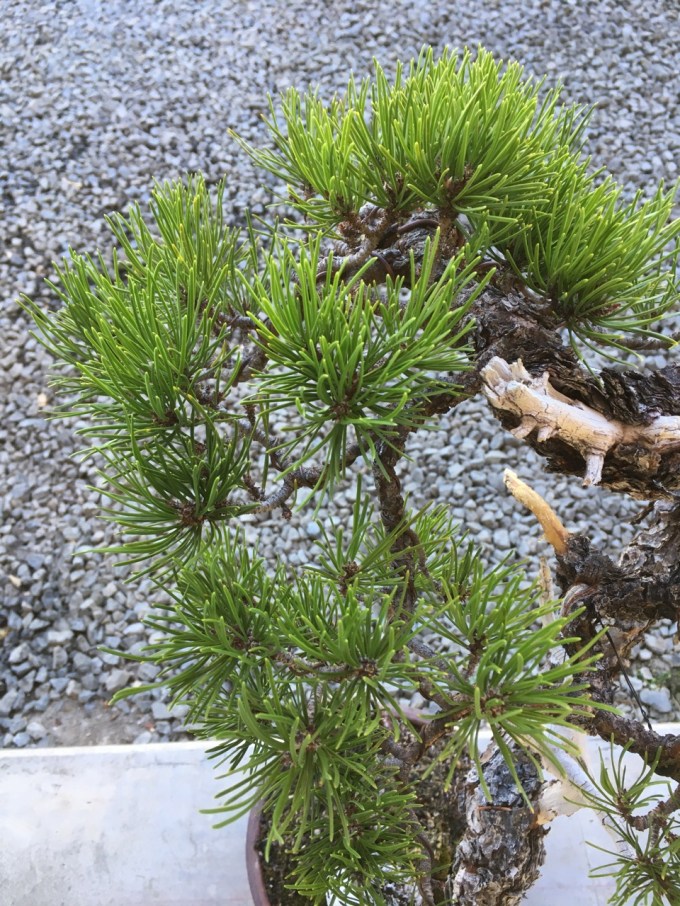Managing Needle Length of Single Flush Pines-
It’s summer and our single flush pines have stopped growing. What now?
For starters we can clean out old needles. While we’re doing this we may notice that some year’s needles are longer than others. This post ends with a few reasons they might be longer and how to plan for the future.

A Shore Pine with some browning and yellowing older needles. These are the third year needles (the juniors).

The removed needles. The large group on top are the old needles, starting to yellow. They were loose and easy to pull off, even though many were still a bit green. The bottom group, the smaller, greener group, were the needles pulled off purely for aesthetic reasons, the dangling ones below the foliar pads. These were mostly second year needles…the sophomores…but more on these shortly.

The tree without three year old needles. Last year’s and this year’s needles remain on the tree. Unless very full, most pines we use for bonsai will want to retain their second year needles. Some second year needle thinning can bring more budding, which is the tree’s response to this, bringing further ramification. Be sure you have a strong tree before doing that, though, and concentrate on taking off some needles on the strong shoots only. If you decide to skip this, at the very least take off the ones that are easy to pull off.
Determining which needles are of which year can be tricky—but looking closely at needle length, needle color, and clumping on the branchlet can help.
Notice that in the smaller pile of needles above (the second year needles) the needles are shorter. Several things can cause needles be shorter:
- less fertilizer
- less frequent watering
- less spring rain
- more sunlight
- smaller pot
Of these the only one we can’t easily control is abundant spring rains. Those rains can make one’s single flush needles grow twice as long in some years.
Shorter needle length gives us a more compact, in-scale tree. As one takes old needles off in the summer routine, take note of how long they are. In comparing their lengths to past years and past care practices one might find a better plan to limit the length of needles for single flush pines the following spring.
11 Comments
How do you reduce candle length on Australian black pine.
Do you mean Austrian perhaps? That’s a single flush pine so there’s no decandling option, but one can use some shortening techniques by pruning in the summer or early fall to bring good budding in the needles and down the branch, given a vigorous plant. Once you have ramification then you’ll be mostly relying on pulling old needle in the strong areas to balance.
thank you Michael for sharing your experiences………… david
Always look forward to your posts. A question if I may. Do you know if Aleppo and Eldarica Pines are single flush?
I used to live in Arizona and should know this one. Some of the Mediterranean pines can be decandled. Anyone care to chime in here?
Thanks for sharing such knowledge.
Could you please share how to get back budding on shore pines?
Also is it possible to do grafting (I have a shore pine with leggy branches).
Thanks
Regards,
Vin
I’d have to get back to you on grafting, we’re going to try this coming spring. As for budding, as long as you don’t have bark yet the shore pine does backbud rather well. Keeping in good sun helps, and taking off some (not too many) older needles can help suggest to the plant to grow buds.
I’ve seen some practitioners online teach that back budding on many single flush pines (in development) can be achieved by letting the candles fully elongate and gather strength in spring and early summer. When the new growth hardens off, it can be cut back either entirely or left with only a couple pairs of the current year’s needles. Do you agree with this method? Does it work for both p. parviflora and p. sylvestris?
That technique may work on a young or very vigorous in-development plant, though I’d be cautious of using the complete removal of shoots as a maintenance technique for old trees. I do not use it myself. You can get a lot of budding on the plant, needle buds and the like, if the tree is young enough / vigorous enough, as it must produce a bud, or die. If the tree is an old established bonsai it might just choose the later option…hence I would be very hesitant to use this on single flush pines of any sort. Leaving some needles as the second option would be safer, but it’s still a very strong technique, and is not used in Japan for old tree maintenance.
Hi, Michael, I hope you still monitor old posts. On this topic I have a scotch pine with a 3″ trunk that I pruned back during the winter. I did not snap the top half of the strong candles in early spring before they open. Now I have a lot of growth; frankly, it’s starting to look bushy. Everything I read about single flush pines is 1) prune during winter, 2) snap long candles before they open, 3) leave it alone spring and summer. Do you agree or can I prune during summer where growth is too thick or to eliminate spots with more than two shoots? Can I simply reduce the length of the shoots in half?
Yes, I agree with those three ideas. I’d wait till fall to begin pruning though. Pruning has really a two-season option,
fall-winter.